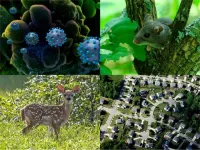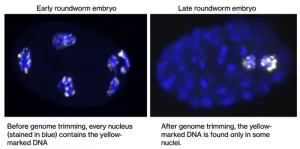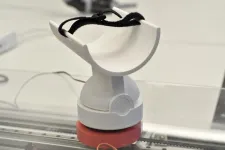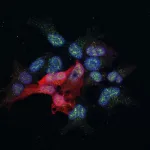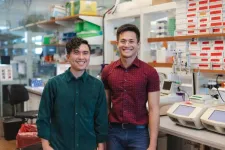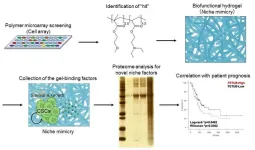(Press-News.org) Many wild animals can carry COVID-19, including those that live among us, such as deer mice, red foxes, white-tailed deer, and more. These species may act as reservoirs, offering new opportunities for the virus to mutate and spill back into people. The omicron variant, for example, is thought to have emerged from mice.
With $3 million in federal grant funding, a new five-year research project will bring together virology, disease ecology, and artificial intelligence to better understand how SARS-CoV-2 (the virus that causes COVID-19) behaves in natural ecosystems, to anticipate strains with the potential to spread widely between people and animals. The award comes from the U.S. Department of Agriculture Animal and Plant Health Inspection Service through the Ecology and Evolution of Infectious Diseases program, a joint effort of the National Institutes of Health, National Science Foundation, and the National Institute of Food and Agriculture.
“In order to know the risk that new variants pose for people, we really have to figure out how SARS-CoV-2 is moving through mammalian wildlife,” explained Barbara Han of Cary Institute of Ecosystem Studies, who will co-lead the new project with Andrew Kramer from the University of South Florida. The project will also assess risk of spillover from people to wildlife, and how new strains could impact ecological communities.
Whereas most current disease surveillance methods collect existing variants and try to pick out the most concerning ones, the new project will use artificial intelligence to predict future variants that don’t yet exist but could be problematic if they emerge. This will generate a surveillance watch-list for the public health community.
“That way, if we find one of these in the wild, we’ll know that we should sit up and pay attention,” said Han.
Because the strategy is proactive instead of reactive, it has the potential to shift the paradigm for how society monitors and manages SARS-CoV-2 transmission in animals, said Kramer.
The project is divided into four parts. Step 1 will use AI to create a library of future strains of SARS-CoV-2 with predicted high zoonotic potential, or the ability to infect both people and animals. In order to do this, the AI will be trained on the sequences and protein structures of past strains.
Step 2 will predict which animals may be susceptible to the variants identified in Step 1, and therefore could serve as potential hosts. Scientists know that SARS-CoV-2 enters mammalian cells through the ACE2 receptor. However, ACE2 receptors are slightly different in every species, and haven’t been studied in the vast majority of mammals. To overcome this dearth of data, the team will use artificial intelligence to predict the structure of ACE2 receptors in various species, and whether or not the variants could bind to the receptors and infect the cell.
Payel Das at IBM Research will lead the AI development needed for Steps 1 and 2. “IBM Research is proud to assist in the prediction of coronavirus transmission between wildlife and humans through the latest cutting-edge AI technologies, including generative AI and foundation models,” said Das. “Ultimately, we hope this work can lead to critical insights that will enable us to better prepare for future human health threats.”
Step 3 is where the AI predictions get tested on real cells in a lab. Virologist Michael Letko of Washington State University will engineer parts of the virus strains identified in Step 1, and see if they actually bind with ACE2 receptors in cells from humans and a subset of the animals identified in Step 2. Results will be used to retrain the AI and further improve the predictions of Steps 1 and 2.
“This part of the study is where we will move from concept to concrete,” said Letko. “Making predictions on a computer is one thing, but to actually see how those predictions perform in a physical and biological context will help us truly understand if our models are accurate.”
He added that since the experiment only uses a small piece of each virus sequence — just the part that binds with the ACE2 receptor on the outside of the cell — there is no potential for it to actually cause an infection, replicate, or spread in any way.
In Step 4, the team will draw on 30 years of environmental monitoring at Cary Institute to simulate a Northeastern forest environment to understand how SARS-CoV-2 moves through real ecosystems where many species are differentially susceptible to infection.
Viral outbreaks in most wild populations are under-observed, with estimations of the curves they follow mostly theoretical. By drawing on field data, the team will use models to account for how wildlife interacts in nature, where you can have multiple infected species interfacing via competition, predator-prey relationships, or other forms of contact.
“By connecting potential variants and their performance in lab assays to species interactions in the real world, we can better understand the real implications of SARS-CoV-2 being spread to many different species at the same time,” said Kramer, who will lead this portion of the study.
Understanding these dynamics should help to improve assessments of risk to wildlife and people, and help predict spillover into humans, said Kramer — not only for SARS-CoV-2, but for other types of animal-borne diseases as well, such as avian influenza.
The team hopes that their results will inform surveillance efforts, for example by identifying potential host species that need to be managed or by immediately sounding the alarm when one of the strains predicted to be a threat pops up in the wild.
xx
Cary Institute of Ecosystem Studies is an independent nonprofit center for environmental research. Since 1983, our scientists have been investigating the complex interactions that govern the natural world and the impacts of climate change on these systems. Our findings lead to more effective resource management, policy actions, and environmental literacy. Staff are global experts in the ecology of: cities, disease, forests, and freshwater.
END
Cary Institute partners on $3M USDA-funded study on COVID-19 variants that could emerge from wildlife
Project combines AI, virology, and ecology to anticipate future SARS-CoV-2 strains with the potential to pass between animals and people
2023-11-09
ELSE PRESS RELEASES FROM THIS DATE:
The enigma of embryonic development: How certain animals trim their genomes
2023-11-09
New research is underway to decipher a fascinating biological puzzle—how some animals can naturally discard more than half of their genetic information during embryonic development.
This radical natural phenomenon has captivated scientists for over 130 years, presenting a tantalizing question in the field of developmental biology and genetics.
Equipped with the latest in genetic engineering tools, the team at The University of Warwick is working to dissect the mechanisms behind this selective genomic editing. By uncovering the processes that allow some nematode worms to abandon up to ...
New URI lab developing adaptive technology, secures National Science Foundation grant
2023-11-09
New URI lab developing adaptive technology, secures National Science Foundation grant
Reza Abiri and Yalda Shahriari receive National Science Foundation award totaling $460,000 for work to improve stroke patient rehabilitation
Passing by Reza Abiri’s office at the University of Rhode Island, one might suspect him of nursing a serious coffee habit. A colorful collection of various mugs and cups dot his office, and though he is friendly enough to likely welcome any visitors stopping by to chat, the cups serve a larger purpose.
Abiri and Yalda Shahriari, professors in ...
MD Anderson announces Institute for Data Science in Oncology to advance mission to end cancer
2023-11-09
HOUSTON ― The University of Texas MD Anderson Cancer Center today announced the launch of its Institute for Data Science in Oncology (IDSO), which integrates the most advanced computational and data science approaches with the institution’s extensive scientific and clinical expertise to significantly improve patient’s lives by transforming cancer care and research.
Bringing top data scientists from a variety of fields together with clinicians and cancer scientists, the institute builds on MD Anderson’s culture of collaboration and connectivity to tackle the field’s most pressing needs in new and innovative ways. IDSO’s efforts have been catalyzed by philanthropic ...
Researchers decipher the mechanism by which the MAF protein promotes breast cancer metastasis
2023-11-09
The MAF protein interacts with the estrogen receptor, alters its function, and promotes the spread of cancer.
The KDM1A enzyme plays a fundamental role in the epigenetic remodelling that facilitates the function of pro-metastatic genes.
The work carried out in Dr. Roger Gomis Lab at IRB Barcelona has been published in the journal Nature Cell Biology.
Barcelona, 9 November 2023 – Breast cancer is the most common form of cancer among women, with more than 2 million new cases diagnosed each year. In cases where the tumour remains localised in the breast, survival rates are remarkably high, ...
New research: Fivefold increase in the melting of Greenland's glaciers over the last 20 years
2023-11-09
New research: Fivefold increase in the melting of Greenland's glaciers over the last 20 years
In the largest survey of its kind ever conducted, using both satellite imagery and old aerial photos from the Danish National Archives, researchers from the University of Copenhagen firmly establish that Greenland’s glaciers are melting at an unprecedented pace. Melting has increased fivefold in the past 20 years. The study eliminates any lingering doubts about the impact of climate change on Greenland's more than 20,000 glaciers.
Based on the most comprehensive monitoring ...
Drug screen points toward novel diabetes treatments
2023-11-09
A drug currently in clinical trials as a cancer therapy can also stimulate pancreatic beta cells to secrete insulin, revealing a previously unknown mechanism for insulin regulation in type 2 diabetes, according to a new study by Weill Cornell Medicine investigators. The preclinical discovery, reported Nov. 9 in Nature Chemical Biology, provides a new chemical tool for probing the biology of diabetes, and could point the way toward better treatments for the disease.
“We have known about insulin for a century, but when it comes to the major mechanisms controlling insulin secretion, there ...
Team creates synthetic enzymes to unravel molecular mysteries
2023-11-09
A University of Texas at Dallas bioengineer has developed synthetic enzymes that can control the behavior of the signaling protein Vg1, which plays a key role in the development of muscle, bone and blood in vertebrate embryos.
The team of researchers is using a new approach, called the Synthetic Processing (SynPro) system, in zebrafish to study how Vg1 is formed. By learning the molecular rules of signal formation in a developing animal, researchers aim to engineer mechanisms — such as giving cells new instructions — that could play a role in treating or preventing disease.
Dr. P.C. Dave P. Dingal, assistant professor of bioengineering in the Erik Jonsson ...
Finding your niche: A synthetic cancer stem cell microenvironment
2023-11-09
Researchers from Tokyo Medical and Dental University (TMDU) report the construction of a synthetic polymer biomaterial that successfully recapitulates the pancreatic adenocarcinoma microenvironment and could be used to identify novel treatment targets
Tokyo, Japan – One of the biggest challenges in biomedical research is finding a way to capture the complexity of the human body in laboratory-based techniques, to enable them to be investigated accurately. Now, researchers from Japan report an approach for precisely imitating a key feature of aggressive cancers in the laboratory.
In a study published recently in Inflammation and Regeneration, researchers from Tokyo Medical and ...
Vigorous exercise, rigorous science: What scientists learned from firefighters in training
2023-11-09
The 11 young firefighters went through a rigorous training exercise, carrying up to 40 pounds of gear over hilly terrain during a 45-minute training exercise in the California sun. Gloves, helmets, flashlights, goggles, and more weighted them down as they sprinted through the countryside wearing fire-resistant clothing to show they were ready to serve as wildland firefighters.
When the training was over, they immediately went to the medical tent—not to rest and recover but to give samples of their blood, ...
Study reveals the structure of brain waves associated with memory consolidation
2023-11-09
The reactivation of patterns of neuronal activity based on experience is crucial for learning and memory, but these patterns and the associated brain waves vary widely and are difficult to classify. Such events, dubbed ripples, are characteristic of the hippocampus, a brain region responsible for memory. Until now, the most common way to study ripples was using frequency analysis, but a project led by the Spanish National Research Council (CSIC) has proposed a new classification strategy.
Using data science tools, a research group from the Instituto Cajal (IC-CSIC) headed by Liset M. de la Prida has managed to figure out the temporal structure of hippocampal ripples. The scientists ...
LAST 30 PRESS RELEASES:
Mysterious iron ‘bar’ discovered in famous nebula
World-first tool reduces harmful engagement with AI-generated explicit images
Learning about public consensus on climate change does little to boost people’s support for action, study shows
Sylvester Cancer Tip Sheet for January 2026
The Global Ocean Ship-Based Hydrographic Investigations Program (GO-SHIP) receives the Ocean Observing Team Award
Elva Escobar Briones selected for The Oceanography Society Mentoring Award
Why a life-threatening sedative is being prescribed more often for seniors
Findings suggest that certain medications for Type 2 diabetes reduce risk of dementia
UC Riverside scientists win 2025 Buchalter Cosmology Prize
SETI Institute opens call for nominations for the 2026 Tarter Award
Novel theranostic model shows curative potential for gastric and pancreatic tumors
How beige fat keeps blood pressure in check
Fossils reveal ‘latitudinal traps’ that increased extinction risk for marine species
Review: The opportunities and risks of AI in mental health research and care
New map reveals features of Antarctic’s ice-covered landscape
Beige fat promotes healthy vascular function and blood pressure in mice
Chronic low-dose pesticide exposure reduces the life span of wild lake fish, China-based study shows
Tiny earthquakes reveal hidden faults under Northern California
Long-term pesticide exposure accelerates aging and shortens lifespan in fish
Professor Tae-Woo Lee's research group develops groundbreaking perovskite display technology demonstrating the highest efficiency and industry-level operational lifetime
The “broker” family helps tidy up the cell
Ecology: Mummified cheetahs discovery gives hope for species’ Arabic reintroduction
Researchers survey the ADHD coaching boom
Air pollution and cardiac remodeling and function in patients with breast cancer
Risk of suicide in patients with traumatic injuries
Post–intensive care syndrome
The lifesaving potential of opioid abatement funds
The Frontiers of Knowledge Award goes to Allan MacDonald and Pablo Jarillo-Herrero for their discovery of the “magic angle” enabling science to transform and control the behavior of new materials
Discovery reveals how keto diet can prevent seizures when drugs fail
JMIR Publications and Sikt announce pilot flat-fee unlimited open access partnership
[Press-News.org] Cary Institute partners on $3M USDA-funded study on COVID-19 variants that could emerge from wildlifeProject combines AI, virology, and ecology to anticipate future SARS-CoV-2 strains with the potential to pass between animals and people
